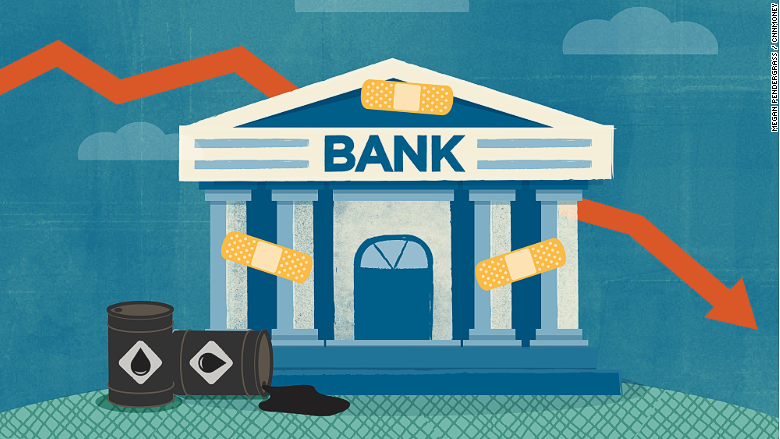
Bad oil loans are piling up at big banks.
The Wall Street firms that bankrolled America's oil boom continue to suffer losses linked to loans that look increasingly shaky given the crash in crude prices. And big banks are bracing for more oil loans to implode.
Bank of America (BAC) on Thursday announced it set aside $997 million to protect from loan losses, mainly in the bank's $22 billion energy portfolio.
Wells Fargo (WFC) warned of "significant stress" and "deterioration" in the oil and gas space. The problems there forced Wells Fargo to add $200 million in loan-loss reserves, its first increase to this rainy-day fund since 2009.
And JPMorgan Chase increased its provisions for credit losses by 88%, mostly due to the oil, natural gas and pipeline business. It was enough to cause JPMorgan's (JPM) first drop in profits since late 2014.
Dick Bove, a banking analyst at Rafferty Capital, said there's "no question" banks are being pressured by the oil crash. "Banks are taking significant charges for loan losses. They are seeing a deterioration of those portfolios," he said.
That's not good because banks are already grappling with a crummy environment. Trading revenue has dwindled and hopes for higher interest rates have been dashed by a cautious Federal Reserve. Extremely low rates make it hard for banks to make money off the difference between the rate they pay depositors and what they charge on loans.
No wonder the financial sector is down 4% this year, the biggest loser in the stock market. Wells Fargo shares slipped another 1% on Thursday, leaving them down 11% in 2016. Other stocks like JPMorgan rose as investors had been fearing worse results.

Related: Why the oil crash ISN'T a repeat of 2008
Even though toxic oil loans are bringing back memories of the financial crisis, the good news is the problem is nowhere near as scary. Yes, banks probably handed out too much credit to oil companies back when crude was sitting at $100 a barrel. And some of those loans will go bad as $40 oil causes cash flows to plunge, fueling a rise in bankruptcies.
But banks have limited exposure. Energy loans make up just 2.5% of bank assets, Goldman Sachs estimates. That pales in comparison with 2007 when souring mortgage loans represented a scary 33% of their assets. Banks are also better prepared because regulators have forced them to stock up on capital that can absorb losses.
"It would be extremely difficult for the oil and gas industry to generate enough losses to cause a disaster in the American banking industry," said Bove.
However, it's clear cheap oil is causing headaches for big banks. Bove said Wells Fargo is being hurt by the oil crash a bit more than its peers because many of its loans are to riskier companies with junk credit ratings. Wells Fargo said it's now sitting on $1.9 billion of nonperforming oil and gas loans, up 72% from the end of 2015.
Still, Wells Fargo notes that its $41 billion of oil and gas exposure is declining and represents a tiny portion of its overall assets.
Related: Oil crash is closing in on its biggest victim yet
Big banks are also guarding against fallout in other parts of the economy. Wells Fargo said it's "actively monitoring" its commercial real estate exposure as well as problems with auto loans in states that rely on the oil industry for employment. Recent research suggests mass oil layoffs may be a factor behind a rise in seriously delinquent subprime car loans.
It will be telling how aggressive banks are about yanking loans to struggling oil companies during the ongoing spring "redetermination" process. This review allows banks to reevaluate the terms of loans that are based on how much oil a company can pump at current prices.
"The banks are not sitting there trying to lose money," said Bove.


